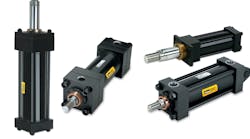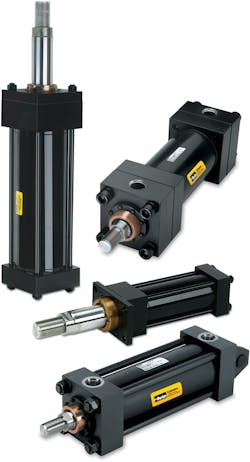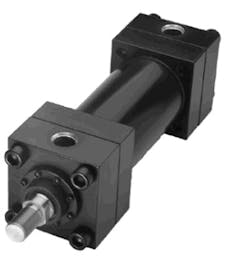Hydraulic cylinders convert fluid pressure and flow into force and linear movement and are used in a wide variety of applications and industries. They are complex devices incorporating a wide range of components available in a range of dimensions and configurations made using a host of different materials.
Many OEM design engineers play it safe by over-engineering cylinder specifications, a precautionary habit in the presence of ever-improving cylinder technologies. Other engineers simply copy previous equipment designs without considering factors that went into the original design and advances made since then. Recycling old designs for a similar function may save time, but it ignores technological advances that improve hydraulic-cylinder efficiency or let them move and support more weight.
Engineers need to stay up-to-date on technologies and approach each new design with the goal of achieving the highest safety, efficiency, and performance goals possible. To that end, this article will explore when to specify hydraulic cylinders over pneumatic ones, the primary design factors to consider when choosing and sizing hydraulic cylinders, common mistakes to avoid, and important design considerations that are often forgotten.
Hydraulic cylinders are complex devices incorporating a wide range of individual components in a multitude of dimensions, configurations and materials.
Hydraulic vs. Pneumatic
The decision between hydraulic and pneumatic cylinders primarily depends on the force density required. Although pneumatic devices are in some respects simpler, they are generally incapable of moving high loads and forces. Pneumatic can generate forces of 15 tons or more, it is typically more economical to use hydraulics for forces over 5,000 lb. Hydraulic cylinders also generate smoother, more controllable movement as they do not suffer from the spring-like actions associated with releasing of gaseous fluid media. As an added benefit, hydraulics can perform ancillary tasks such as lubricating and cooling.
However, since the availability of power and media is a non-negotiable factor in fluid power design, it should be noted that properly designed and sized pneumatics can deliver higher performance if a compact footprint is not needed.
Design Factors for Hydraulic Cylinders
Specifying hydraulic cylinders is essentially a balancing act, as each design factor influences one or more of many design considerations. For example, some urethane seals are ideal for applications as cold as −65°F (−54°C) and will tolerate temperatures as high as 200°F (129°C). Other seal withstand temperatures as high as 500°F (260°C) but cannot handle cold temperatures.
Although NFPA standards and ISO-compliant guidelines are great starting points for designing hydraulic devices, many industries have guidelines of their own. Working with suppliers experienced with all these standards can speed and streamline the design process.
Cylinder manufacturers can offer options that increase the chances properly equipped standard components will meet an application’s design criteria of an application. For example, most cylinder manufacturers offer 19 mounting options, which covers the standard NFPA offerings. Standard components have the additional advantage of being readily available worldwide, expediting just-in-time warehousing and delivery of replacement parts as components eventually wears out.
Major factors is to be considered when specifying hydraulic cylinders include:
Capacity. Medium-duty hydraulics account for most industrial applications and are typically rated at 1,000 psi. Heavy-duty hydraulics are common in hydraulic presses, automotive applications, and other industrial applications. Standard heavy-duty hydraulic cylinders handle pressures as high as 3,000 psi. Load capabilities in these heavy-duty machines are relative to the piston area (in in.2) exposed to fluid pressure multiplied by the gauge pressure (in psi). Engineers can meet much higher load requirements without sacrificing other areas of performance by using tandem-cylinder designs rather than larger bore or custom high-pressure cylinders.
Stroking distance. Although custom stroke distances can exceed 10 ft (3.05m), pressure rating can then be a concern. Engineers need to determine if the rods must be thicker or not to handle the load over long strokes. If necessary, a pressure rating on load in thrust (push mode) must be specified. Rod sag from horizontal applications with long strokes may lead to premature rod bearing wear. Weighing each positive effect against potential negatives is essential to optimizing hydraulic equipment performance.
Speed. Every application engineer has their own definition of “excessive speed.” As a good rule of thumb, standard hydraulic cylinder seals easily handle speeds up to 3.28 ft (1 m) per second. The tolerance threshold for standard cushions is roughly two-thirds of that speed. Frequently, a standard low-friction seal is the better choice for higher-speed applications. But here, too, what you gain in one aspect of performance you lose in another. The greater the fluid velocity, the higher the fluid temperature, so when opting for speed-increasing customizations, it is essential to consider the effect higher temperatures will have on the entire hydraulic system. In some devices systems, over-sizing the ports may eliminate concerns about higher temperatures.
Temperature. Hydraulic cylinders using standard components can operate in temperatures from 500°F (260°C) to −65°F (−54°C). But temperatures effect both the “hard” and “soft” design components of cylinders. Applications requiring temperature extremes at either or both ends of thermometer require extensive knowledge of the interdependency of individual components to get the best balance of short- and long-term performance. For example, applications in outdoors Alaska will see seals and metal parts contract due to extreme temperatures.
Ancillary components such as switches can also be affected by environmental factors. For example, compact hydraulic cylinders were used in high-temperature applications and the grooves in the aluminum cylinder body were used for switches. Within the application, high-force magnetic clamps moved finished dies on the shop floor. The customer noticed that the switches did not activate in certain locations. When the cylinders were removed from the die, the switches started working again. The engineers found that a magnetic field created by the clamps and interfered with the switches. Temperature can also cause problems with switched. In one case, while the cylinder seals operated fine in high temperatures, there was enough heat to degauss the magnet inside the cylinder and lead to inconsistent switching. In this case, the customer noticed that the switch worked well for the first hour or so and then began to fault out. As the magnet reaches 176°F, it begins to lose strength. It doesn't lose it entirely unless a much higher temperature is reached, but the magnetic field weakens enough to make the switches stop working.
Long-stroke hydraulic cylinders designed without tie rods offer significant benefits when it comes to maintenance.
Mounting styles. There are three mounting styles for hydraulic cylinders: pivot, fixed, and offset pivot. Fixed and pivot mounts absorb forces on the cylinder’s centerline and typically include medium- and heavy-duty mounts for accommodating thrust or tension. Offset fixed mountings supports the entire cylinder by the mounting surface below cylinder centerline rather than absorbing forces only along the centerline.
There are several standardized mounts within these categories. Engineers can use these offerings for an ever-widening number of application requirements. NFPA tie rod cylinders, which are used in the majority of industrial systems, are typically mounted using a variety of standard mating configurations including trunnion-style heads and caps, extended tie rod cap and/or head end styles, flange-style heads, side-lug and side-tapped styles, spherical bearings, and cap-fixed clevis designs. Most of these mounting options are available for single-acting and double-rod cylinders.
The mounting should absorb the force, stabilizing the device and improving performance. For rods loaded primarily in compression (push), cap-end mounts are recommended; for those in tension (pull), a head-end mount is preferred.
It is the amount of tension or compression that determines piston-rod diameter and the amount of pull or push that determines bore diameter. Other relevant factors to consider when selecting a mounting style include load, speed, and cylinder motion (straight/fixed or pivot).
Every mounting type has both benefits and limitations. For example, trunnions for pivot-mounted cylinders won’t work with self-aligning bearings where the small bearing area is located a distance from the trunnions and cylinder heads. This can introduce bending forces that overstress the trunnion pins.
Many performance expectations at first glance seem to require custom mounts. But with a little design work, they can be accommodated with existing styles, sometimes with only slight modifications, making replacements easier and reducing costs.
Cylinder bore size. Bore size is related to operating pressure. The amount of push or pull force required determines the bore size needed. Earlier steel and aluminum mill equipment often required non-standard bore and rod sizes. Today, virtually every industrial requirement can be met with NFPA standard and/or ISO-compliant components.
Piston rod size. OEM engineers probably request customized piston rod sizes more frequently than any other hydraulic cylinder component. What is not always considered is the simple fact that push or pull never depends on stroke length. Just as a pushed rope holds a straight line only in relation to its length (the longer the rope, the more the rope curls), piston rods under compression or tension tend to diffuse force non-linearly.
Specifying costly materials such as stainless or alloy steels for the rods is a common example of over-engineering. In most extreme applications, chrome plating enough corrosion-resistance required to ensure a long-lived rod.
Necessary column strength is often overlooked when selecting rod diameters. In addition to considering how much force it can push with, also ask, “How strong is this column extending out here?” If we don’t work with engineers in the design phase, we likely don’t know if it’s a compressive or tension load. Column strength is the parameter that gets overlooked most often when selecting piston-rod diameters.
Cylinder configurations. For applications requiring equal forces on both sides of the piston, a standard double-acting cylinder using pressure to extend and retract the cylinder, combined with a four-way directional control valve to direct pressure to either the head or the end cap, is almost always preferable to more customized solutions. An experienced cylinder manufacturer will be familiar with every conceivable cylinder assembly configuration, and the unintended consequences of customizing individual components vs. combining standard cylinders in creative ways to meet unusual performance requirements.
Rod ends and threading. This is one area where standard options are so vast, customization is rarely needed. Plus, standard threads can be made in inch or metric format. Typically, each available diameter is available in four distinct rod end styles.
Even in those rare instances where modifications seem to be necessary, it is important to consider the effects of modifications on accessories. The relatively small performance compromise resulting from standardizing rod ends is almost always warranted by the versatility they afford.
Even a modest modification such as under-sizing threads requires de-rating the cylinder and may necessitate special tooling for non-standard pitch, resulting in delays, expense, and the inability to readily mate with accessory components.
Cylinder body tube. Standard cylinder bodies are plain steel or chromed plated and can handle most applications. The use of alloy steels, stainless steel, or brass is prevalent in special applications such as watery environments.
Stop tubing. Stop tubing lengthens the distance between rod and piston bearings to reduce bearing loads on push-stroke cylinders when they are fully extended. Stop tubing is especially critical for horizontally mounted cylinders where it restricts the rod’s extended position. In such applications, increasing the distance improves stability and increases bearing life.
Seals. Experienced hydraulic manufacturers offer seals that meet a full range of temperatures and fluid types and can help engineers find seals that will match precise application requirements.
Necessary column strength is often overlooked when selecting the rod diameter for a hydraulic cylinder.
Safety
Engineers make three common mistakes when it comes to safety: omitting the safety factor in cylinder sizing; assuming certain accessories are safety devices when they are not; and using the wrong thread or coupling style for the application.
In sizing cylinders, a safety factor, also called a thrust factor, should be included in the design. For example, if you’re going to have a 100 lb load, you should not specify a cylinder capable of pushing 100 lb because that is the load’s equilibrium point and it will not move. If you sized the cylinder for only 110 lb, your machine may work initially, but after a couple of months, the cylinder may seem like it’s not working. This may be due to pressure loss, seal wear, increased friction, or a variety of other issues. Make sure to include a factor beneficial to maintaining operations and in avoiding potentially dangerous situations around the machinery.
When it comes to safety standards, a common misconception is that rod locks (aka brakes) are appropriate safety devices. But they are not classified as such. Safety devices are often included in addition to the cylinder rather than built in. Because a cylinder creates motion, it is not possible to add something to the cylinder that will prevent a rod end break and stop the motion. Design engineers should consider safety catchers mounted in parallel with the cylinder. They will stop motion in emergencies. Safety devices should be specified as redundancies or running in parallel to the cylinder.
Additionally, some engineers do not realize that a flange coupling should not be used in tension applications because it acts on a much smaller area of the rod than the overall diameter. If flange couplings used in tension applications are pulled, the flanges or buttons can snap off, causing the die come crashing down.
The goal of every mounting design for a hydraulic cylinder is to let the mount absorb force, stabilize the hydraulics, and improve performance.
Other Considerations
Every industrial application is unique and there are many ancillary components involved in hydraulic cylinder specification. Energy-absorbing cushions, pillow blocks, regenerative circuits, and over-- and under-sizing ports can all contribute to improving the performance of hydraulic systems, depending on the application’s performance requirements.
If you’re using an alignment coupler, you’ll need to ensure it has the force to handle the load. Many are rated for a little more than the output of the cylinder they’re put on. But there could be a case where a larger-bore cylinder has a small rod end, so the rod-end accessory that fits may not have tensile strength to handle the load. In such case, different materials should be considered. For example, rather than using a cast piece, use a machined piece such as a rod clevis, or consider stainless steel instead of ductal iron to get more tensile strength. There are some instances where you need a stronger accessory than seems necessary for the cylinder specified.
Selecting appropriate ancillary components can present a specification challenge. For example, cushions are supposed to slow the force of motion, but OEM engineers sometimes overlook the fact that fluids do not typically moving very fast and may not require back-ups in all situations. An engineer may be tempted to take a “belt-and-suspenders” approach to designing push/pull retarder using cushions with spring cylinders, overlooking the fact that oil needs to work its way through the cap, hoses, valves and so on. In such cases, specifying standard single action cylinders with cushions may be wiser than trying to insert cushions into spring cylinders.
There are certainly times when getting the right cylinder requires some customization either in component size, material, or configuration. However, far more often than not, partnering with experienced cylinder application engineers at the supplier early in the design process will save time and money while ensuring the cylinder will handle its duties as efficiently as possible for as long as possible.
Brad Price is a cylinder application engineer at Parker Hannifin Corp.





